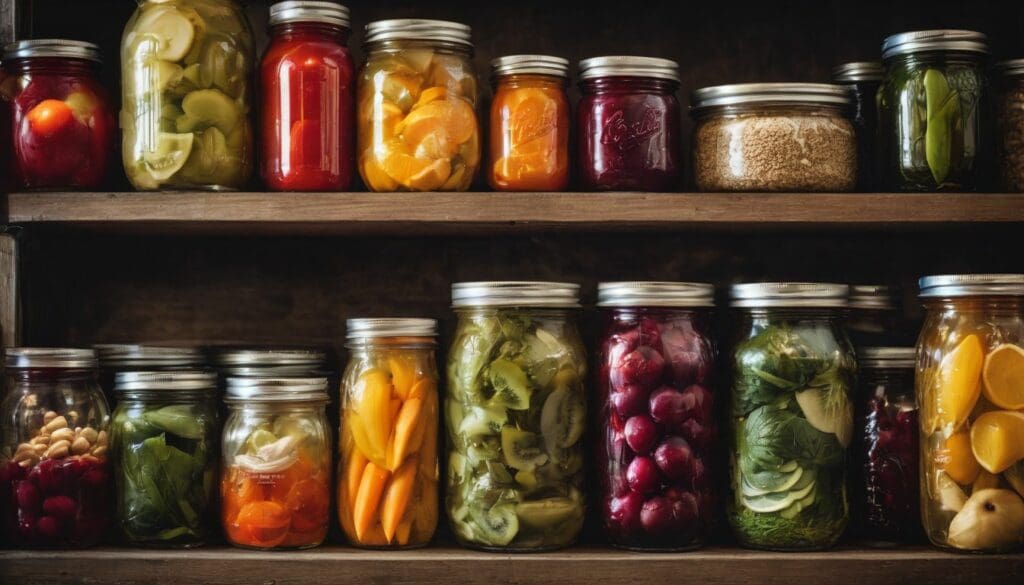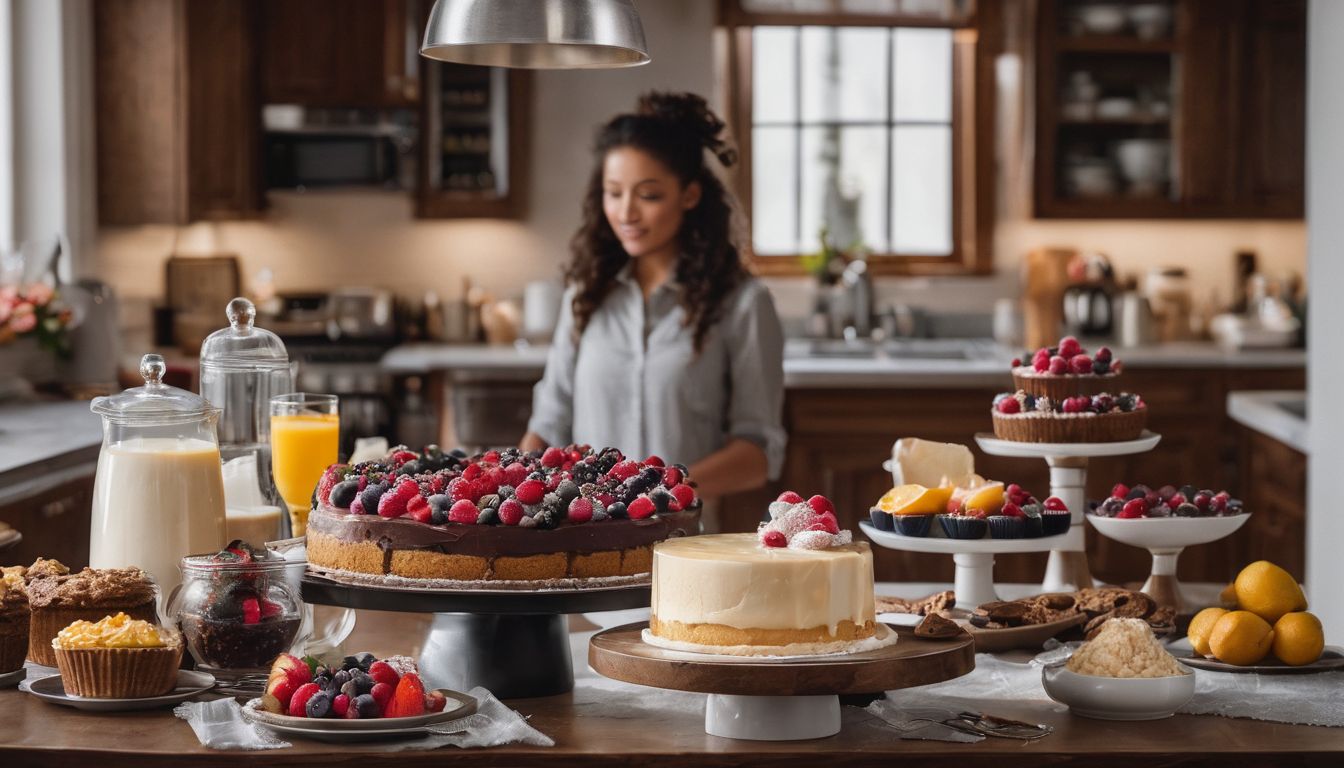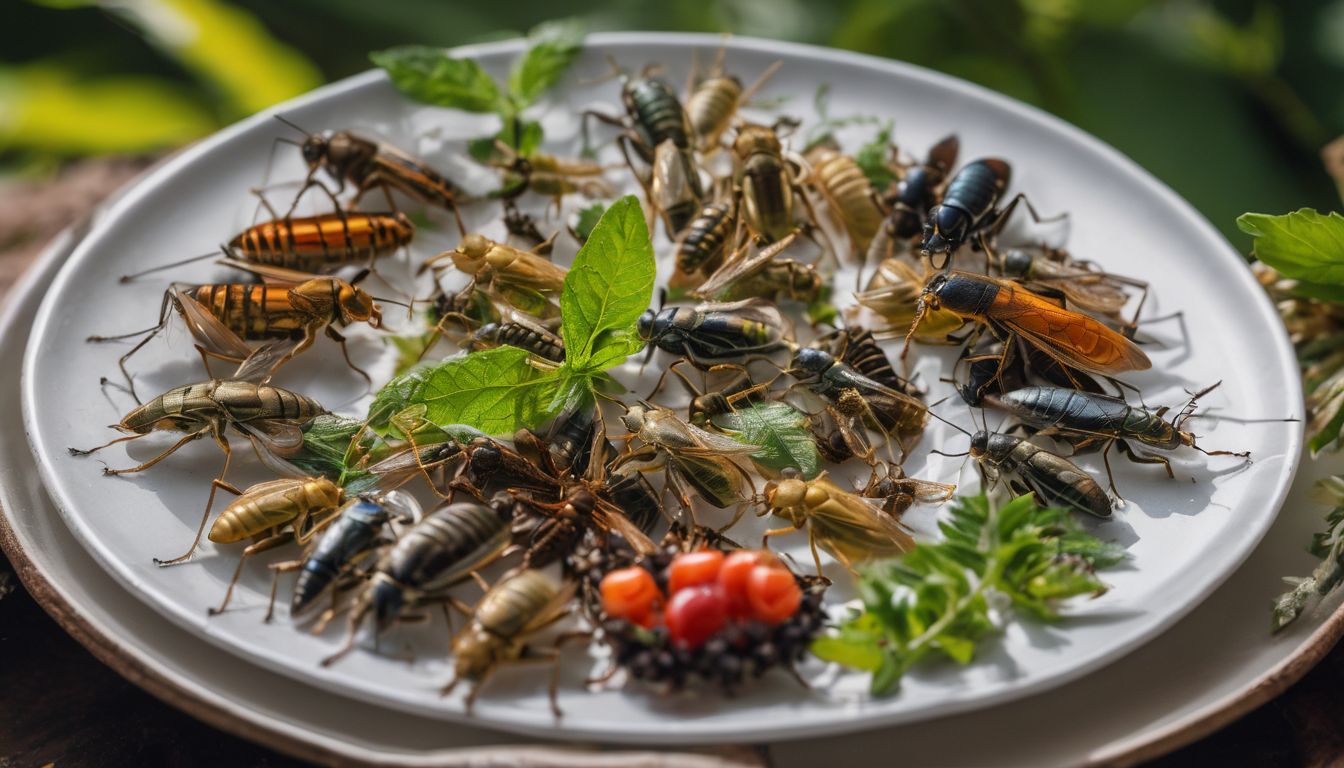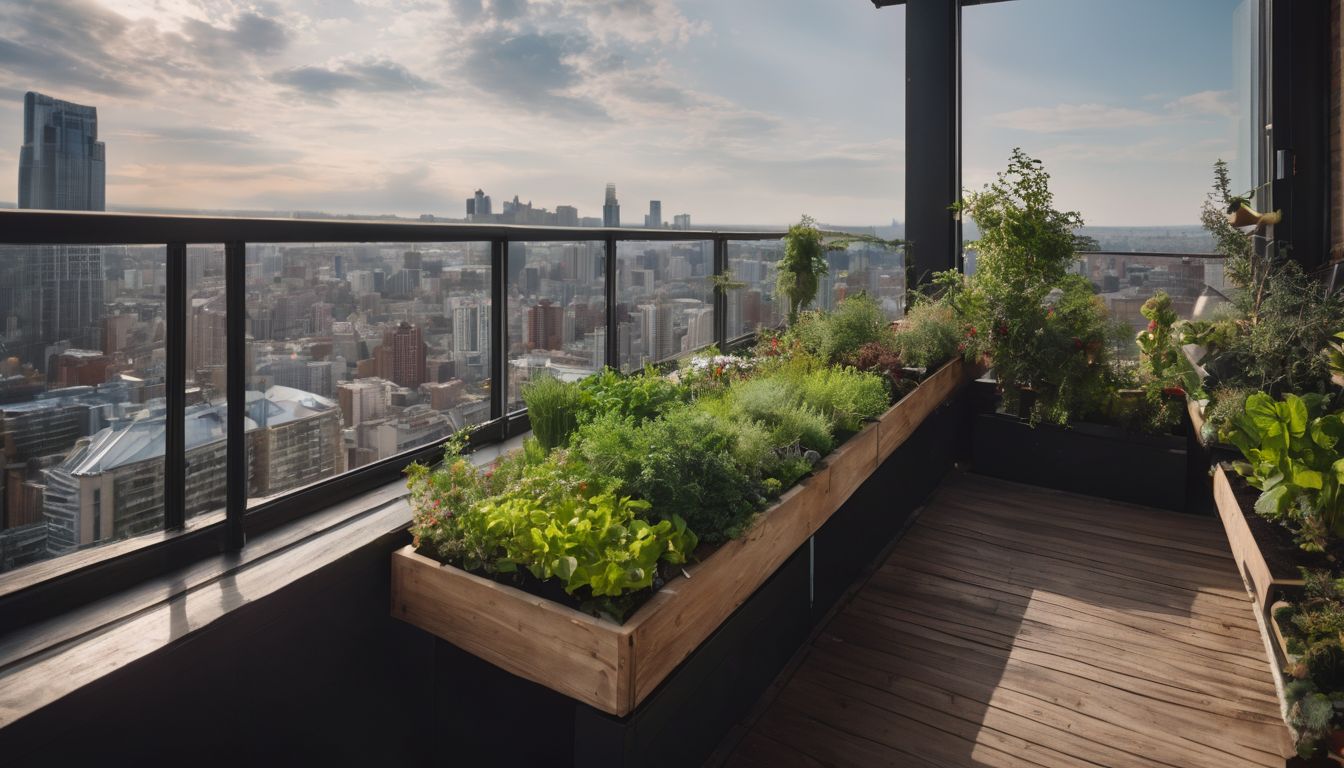Are you looking to keep your pantry stocked with homemade goodness all year round? Home canning preserves the taste of summer‘s bounty for those cold winter months. Our step-by-step guide will walk you through preserving your own food safely and deliciously at home.
Let’s jar up some flavour!
Key Takeaways
- Home canning is a method to preserve food which involves storing it in airtight containers; this includes water bath and pressure canning for high-acid and low-acid foods respectively.
- By following strict guidelines, such as sterilising jars and using fresh ingredients, home canning ensures safe consumption of preserved foods while allowing you to enjoy seasonal produce year-round.
- Properly sealed and stored canned goods generally maintain optimal taste and nutrition for up to one year; however, regular inspection for spoilage signs like off odours or bulging lids is crucial.
- Reprocessing unsealed jars with new lids after checking for defects is important to avoid wasting food and ensure safety when initial sealing fails.
- Using tested recipes from reliable sources like university extensions helps prevent the growth of harmful bacteria during home canning, making the process both enjoyable and secure.
What is Home Canning?
Home canning is the process of preserving and storing food in airtight containers to extend its shelf life. There are two main types of home canning: water bath canning for high-acid foods like fruits and pickles, and pressure canning for low-acid foods like vegetables and meats.
Benefits of Home Canning
Home canning empowers you to store fresh produce for months, reducing food waste and saving money. By preserving fruits and vegetables at their peak, you lock in flavour and nutritional value.
This method cuts down on your carbon footprint as it lessens the reliance on commercially canned goods, which often require more energy and resources to produce.
Preserving your harvest with mason jars also enables a sustainable lifestyle choice, aligning with conservation ideals. You avoid the excess packaging associated with store-bought items, leading to less plastic and metal ending up in landfills.
The process keeps preservatives out of your diet too, ensuring you have access to wholesome ingredients year-round.
Types of Canning
Water bath canning and pressure canning are the two primary methods for preserving food at home. Water bath canning is suitable for acidic foods, such as fruits, pickles, and jams, while low-acid foods like vegetables and meats require pressure canning due to their susceptibility to harmful bacteria.
In water bath canning, jars are submerged in boiling water to create a high-temperature environment that destroys bacteria and enzymes. Conversely, pressure canning uses elevated pressure and temperature levels to eliminate botulism spores found in low-acid foods.
Both methods play a crucial role in extending the shelf life of food items while maintaining their nutritional value.
An alternative method called open kettle or atmospheric steam canning is sometimes used for preserving high acid-foods; however, it’s important to note that this method does not produce reliable sterilisation required for safe preservation.
Water Bath Canning
After understanding the different types of canning, it’s important to focus on water bath canning. This method is suitable for high-acid foods such as fruits, pickles, and jams. Water bath canning involves submerging sealed jars in a large pot of boiling water for a specific period.
The heat from the boiling water kills bacteria and creates a vacuum seal on the jar. It’s an effective way to preserve food without requiring specialised equipment.
When using this method, ensure that the jars are fully submerged in water and have at least 1-2 inches of water covering them. A jar lifter comes in handy for adding and removing jars from the boiling water bath.
Pressure Canning
When pressure canning, high temperatures are used to safely preserve low-acid foods like vegetables, meats, and poultry. This method is essential for killing harmful bacteria such as botulism spores that thrive in low-acid environments.
By using a pressure canner, the internal temperature reaches 240°F (116°C) or higher, effectively destroying any microorganisms present in the food.
Next up: “The Canning Process”
The Canning Process
Prepare your equipment and jars, select and prepare your food, then follow the steps for water bath or pressure canning – read more to start preserving your own food at home!
Preparing equipment and jars
To begin home canning, gather the necessary equipment and jars. Here’s a detailed list of the steps:
- Wash all equipment and jars with hot, soapy water, then rinse thoroughly.
- Inspect the jars for any chips or cracks that could prevent a proper seal.
- Ensure that lids and bands are in good condition, without dents or rust.
- Sterilise the jars by boiling them in a large pot of water for 10 minutes.
- Keep the jars warm until ready to use by placing them in a low – temperature oven or in simmering water.
Selecting and preparing food
- Wash all fruits and vegetables thoroughly under running water to remove any dirt or debris.
- Trim and discard any damaged or bruised areas on the produce.
- For items like peaches, tomatoes, or grapes, blanch them in boiling water for a brief period to make peeling easier.
- For firmer fruits and vegetables like apples or cucumbers, slice them evenly into consistent pieces.
- Utilise fresh herbs and spices to enhance flavour but avoid adding excessive salt or sugar.
- Steps for different canning methods
Steps for different canning methods
Home canning involves different methods to preserve food. Each method has specific steps to ensure safety and quality. Here’s a brief outline of the steps involved in water bath canning and pressure canning:
- Prepare your equipment and jars by washing them with hot, soapy water.
- Next, select and prepare your food according to a tested recipe.
- Fill the canner halfway with water and preheat it while preparing your jars for filling.
- Place the filled jars onto the rack in the canner, ensuring they are fully submerged in water.
- Process the jars for the required time according to your recipe, then carefully remove them from the canner.
- After washing your equipment and jars, check that all components of your pressure canner are working properly.
- Prepare your low – acid foods following a reliable recipe.
- Add 2 – 3 inches of hot water to the pressure canner and place filled jars on the rack inside.
- Securely fasten the lid, allowing steam to vent for 10 minutes before placing the pressure regulator on.
- Process filled jars at the correct pressure for the specified time according to your recipe before turning off the heat.
Safe Canning Practices
When it comes to safe canning practices, it’s crucial to avoid contamination and properly handle processed jars. Knowing how to reprocess unsealed jars is also important for ensuring the safety of your canned goods.
Avoiding contamination
When canning at home, it’s crucial to avoid contamination by maintaining cleanliness. Wash hands and surfaces diligently with warm, soapy water before handling food or equipment. Also, clean fruits and vegetables thoroughly to remove any dirt or debris.
Another vital step is sterilising jars and equipment to prevent the growth of harmful bacteria. Furthermore, make sure to use fresh ingredients and follow tested recipes precisely to maintain safety standards.
Lastly, store canned goods in a cool, dark place to preserve their quality.
To prevent contamination during the canning process:
1. Wash hands and surfaces thoroughly.
2. Clean fruits and vegetables diligently.
Proper storage and handling of processed jars
Once your jars have been properly processed, cool them on a towel away from drafts. After 12 to 24 hours, remove the bands and check the seals. Wipe down the jars and store in a cool, dark place.
Ensure that you label each jar with its contents and date of canning for easy identification.
Inspect all jars regularly for signs of spoilage or leakage. When opening a jar, smell the contents for off odors and look for any visible mold or unnatural bubbling. If any of these signs are present, discard the food immediately to prevent illness.
How to reprocess unsealed jars
If a jar doesn’t seal properly, it can be reprocessed to ensure food safety.
First, carefully remove the food from the unsealed jar. Then, check for any nicks on the rim of the jar or debris that may have prevented sealing. Next, use a new lid and reprocess following the recommended method for your specific food type and canning process.
Remember to always inspect jars before use and avoid using jars with cracks or chips for canning. Ensuring proper sealing is crucial in preserving food safely.
Troubleshooting and Safety Measures
Learn how to identify signs of spoilage in canned foods, including off-odors and discoloration. Discover the proper steps for detoxifying low-acid foods and essential safety precautions for pressure canning to ensure a safe and successful home canning process.
Signs of spoilage
Look for signs of spoilage in canned food. Check for bulging lids, leaks, or broken seals, as these indicate contamination and possible spoilage. Also, pay attention to off-putting odours, unusual colours, or strange textures when inspecting the contents of a jar – these are all indicators that the food may no longer be safe to eat.
If you notice any of these signs during inspection or when opening a jar, it’s important to discard the contents immediately. It’s better to err on the side of caution when it comes to preserving your health and safety against potential foodborne illness.
How to detoxify low-acid foods
To detoxify low-acid foods, the first step is to discard any visibly spoiled food. Then, cut away any bruised or damaged areas before thoroughly washing the remaining portions. Next, blanch the food by briefly immersing it in boiling water and then rapidly cooling it in ice-cold water.
For added safety, use a food thermometer to ensure that all parts of the item reach a safe temperature during processing. Additionally, always follow approved canning recipes and methods for best results.
It’s important to note that pressure canning is the only method recommended for preserving low-acid foods such as vegetables, meats, and poultry due to their susceptibility to harmful bacteria like botulism.
Safety precautions for pressure canning
Pressure canning requires careful attention to safety. Always use a tested and reliable pressure canner. Check the seals and gaskets regularly for wear or tear, and replace them as needed.
Follow the manufacturer’s instructions for proper maintenance and usage of your canner. Vent the canner before starting the process to remove any trapped air, ensuring that steam flows freely.
Use caution when releasing the pressure after processing – follow the recommended methods to avoid burns from hot steam or liquid.
Monitor the pressure gauge closely throughout processing, adjusting heat levels as needed to maintain a consistent pressure. Never leave a pressure canner unattended while it is in operation, and be mindful of children and pets around this potentially hazardous equipment.
Conclusion & Resources
In conclusion, home canning and preserving is an effective way to store food for longer periods. For more information on recipes and resources, continue reading our blog.
Recap of the canning process
To recap the canning process, start by preparing all necessary equipment and jars. Then, select and prepare the food to be canned according to safe guidelines. Follow specific steps for water bath or pressure canning methods as required.
Ensure a high-temperature processing environment for safe preservation of the food items. Lastly, store the processed jars properly to maintain their long-term shelf life.
Through this step-by-step process of home canning and preserving, individuals can successfully contribute to environmental conservation efforts while enjoying homemade jams and pickled goods year-round without relying on store-bought alternatives that may come with excess packaging waste.
Navigating food preservation resources
When seeking food preservation resources, it’s essential to start with reputable sources. Look for government extension services, which provide reliable information on canning techniques and safety guidelines.
Online platforms like the National Center for Home Food Preservation offer detailed guides on canning different foods and troubleshooting common issues. Additionally, joining local community groups or forums dedicated to home canning can provide valuable firsthand tips and recommendations from experienced individuals.
For those interested in exploring traditional recipes or learning about innovative preservation methods, visiting farmers’ markets or attending workshops hosted by local experts can be enlightening experiences.
Where to find canning recipes
You can find a plethora of canning recipes in cookbooks, online blogs, and on websites dedicated to food preservation. Many government agricultural extensions and university horticultural departments also offer reliable recipes.
For those who prefer hands-on learning, consider attending workshops or classes offered by local community centres or gardening clubs.
Exploring various recipe sources will provide you with an abundant selection of traditional favourites and innovative combinations that cater to different taste preferences and dietary needs.
FAQs
1. What is home canning and preserving?
Home canning and preserving are techniques used to process food for long-term storage by using high temperature processing to seal them in airtight containers.
2. What equipment do I need for home canning?
For home canning, you’ll need specific canning equipment like jars, lids, rings, and a canner or large pot designed for food preservation methods.
3. How does the food canning process ensure food safety?
The food canning process uses high temperatures to kill bacteria and creates a vacuum seal during cooling which prevents new germs from entering the jar ensuring safe food storage.
4. Can I use these methods for pickling vegetables?
Yes, pickling is a popular form of home preservation that also involves storing foods in vinegar or brine solution, often done as part of the overall home-canning procedure.
5. Are there guidelines I should follow when doing home preservation?
Absolutely! It’s important to follow precise canning guidelines including specific times and temperatures needed for safe processing of different types of foods.





